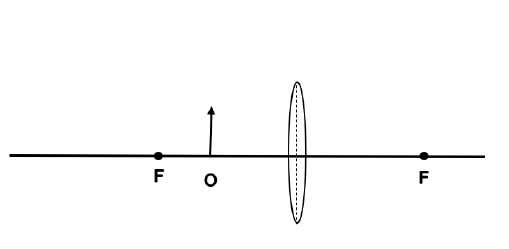Technical Sciences Paper 1 Questions - Grade 12 June 2021 Exemplars
Share via Whatsapp Join our WhatsApp Group Join our Telegram GroupINSTRUCTIONS AND INFORMATION
Read the following instructions carefully before answering the questions.
- Write your FULL NAME and SURNAME in the appropriate spaces on the ANSWER SHEET.
- Answer ALL the questions.
- Start each question on a NEW page in the ANSWER BOOK.
- You may use a non-programmable calculator.
- You may use appropriate mathematical instruments.
- Number the answers correctly according to the numbering system used in this question paper.
- Show ALL formulae and substitutions in ALL calculations.
- Round off your FINAL numerical answers to a minimum of TWO decimal places.
- Give brief motivations, discussions, et cetera where required.
- You are advised to use the attached DATA SHEET.
- Write neatly and legibly.
QUESTIONS
QUESTION 1: MULTIPLE-CHOICE QUESTIONS
Various options are provided as possible answers to the following questions. Choose the answer and write the letter (A–D) next to the question numbers (1.1–1.10) in the ANSWER BOOK, for example 1.11 E.
1.1 Which ONE of the following is defined as the tendency of an object to resist a change in its state of motion?
- Inertia
- Force
- Weight
- Impulse (2)
1.2 The SI unit of the quantity rate of change of momentum is ...
- kg.m.s-1.
- N.s.
- J.
- N. (2)
1.3 An object has a constant acceleration of 0,2 m.s-2.
The constant acceleration of 0,2 m.s-2 means that the object’s …
- speed is constant.
- direction is changing.
- velocity changes by 0,2 m.s-1 every second.
- displacement changes by 0,2 m. s-1 every second. (2)
1.4 Which of the following quantity (ies) is/are CONSERVED in both ELASTIC and INELASTIC collisions?
- Momentum only
- Kinetic energy
- Both momentum and kinetic energy
- Neither momentum nor kinetic energy (2)
1.5 Airbags in modern cars provide more safety during an accident.
Which ONE of the following combinations is CORRECT regarding TIME OF CONTACT and the NET FORCE acting on a passenger during a collision in a car fitted with airbags?
TIME OF CONTACT | NET FORCE | |
A | Increases | Increases |
B | Increases | Decreases |
C | Decreases | Increases |
D | Decreases | Decreases |
(2)
1.6 When a force F is applied on an object P by an object Q, the object P will exert a force of equal magnitude on object Q in the opposite direction.
What is the NAME of the law stated above?
- Newton’s First law
- Newton’s Second law
- Newton’s Third law
- Pascal’s Law (2)
1.7 Mechanical energy is defined as …
- product of force and time.
- work done divided by time .
- product of force and veloc ity.
- sum of gravitational potential energy and kinetic energy. (2)
1.8 The ratio of change in dimension to the original dimension is called …
- strain
- stress
- elasticity
- elastic limit (2)
1.9 In the ray diagram below an object is placed at point P beyond the focal point F of a lens.
The characteristics of the image of the object placed at point P as shown in the diagram will be …
- real, smaller and upright.
- real, smaller and inverted.
- virtual, smaller and inverted.
- virtual, smaller and upright. (2)
1.10 Light rays that enter the eye are refracted by the eye lens and cornea so that they can focus on the back of the eye.
If the rays of light do not focus on the back of the eye as shown in the diagram below, a blurry image will result which may be corrected by glasses or contact lenses.
Which ONE of the following CORRECTLY gives the TYPE of lens to be used to correct the condition and the reason for using the lens?
TYPE OF LENS | REASON FOR USING THE LENS | |
A | Concave | To diverge light entering the eye |
B | Concave | To converge the light entering the eye |
C | Convex | To diverge light entering the eye |
D | Convex | To converge light entering the eye |
(2) [20]
QUESTION 2 (Start on a new page.)
2.1 A block of mass 5 kg is pushed by means of a stick, held at an angle of 20° to the horizontal as shown in the diagram below. The block moves horizontally to the right.
Part APC is FRICTIONLESS while CD is a ROUGH surface.
The force diagram below shows all the forces acting on the box BEFORE it reaches point P.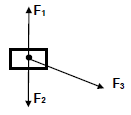 Name the following forces:
Name the following forces:
2.1.1 F1 (1)
2.1.2 F2 (1)
2.2 F2 and another force, F4, are ACTION-REACTION pairs.
2.2.1 Describe force F4, the action-reaction pair of force F2. (2)
2.2.2 Calculate the magnitude of F4. (3)
2.3 When the block reaches point P the stick is REMOVED, and the block continues moving until it reaches point D.
2.3.1 Name and state the law that explains why the block continues moving after the stick is removed at point P. (3)
2.3.2 Write down the value of the net (resultant) force acting on the block as it moves between points P and C. (1)
[11]
QUESTION 3 (Start on a new page.)
3.1 Two crates X and Y, connected by a light inextensible string, are pulled with a force of 40 N that acts at 35° to the horizontal, as shown in the diagram below.
The frictional force acting on crate X is 6 N while part QR is FRICTIONLESS.
3.1.1 Explain why the string must be inextensible. (2)
3.1.2 State Newton’s Second Law of motion in words. (2)
3.1.3 Calculate the magnitude of the acceleration of the crates before crate X reaches point Q. (7)
3.1.4 What will happen to the acceleration calculated in QUESTION 3.1.3, if the angle 35° shown in the diagram is increased to 60°? Write only INCREASES, DECREASES or REMAINS THE SAME. Explain your answer. (3)
3.2 Learners perform an investigation to determine the relationship between net force and acceleration.
The learners performed TWO experiments (A and B), using a different mass in each experiment.
The learners recorded their results for experiments (A and B) in a table and used them to draw the graph shown below.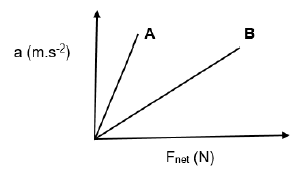
For investigation A, write down the:
3.2.1 Controlled variable (1)
3.2.2 Conclusion that can be drawn from the graph about the relationship between acceleration and net force (2)
3.3 In which experiment was a LARGER mass used? Use information from the graph to explain the answer. (4)
[21]
QUESTION 4 (Start on a new page.)
4.1 Two cars, P and Q, of masses 800 kg and 2 000 kg respectively, move in the same direction, east, and collide as shown in the diagrams below.
Before the collision car P is moving at a speed of 20 m.s-1 and car Q has a kinetic energy of 112 500 J.
BEFORE THE COLLISION
AFTER THE COLLISION
After the collision both cars, P and Q, continue to move east. Car P has a velocity of 12 m.s-1 after the collision.
4.1 State the principle of conservation of momentum. (2)
4.2 Calculate the velocity of car Q after the collision. (4)
4.3 Determine by calculation whether the collision is ELASTIC or INELASTIC. (5)
4.4 The time of contact during the collision is 0,15 s.
Calculate the net force on car P during the collision. (4)
[15]
QUESTION 5 (Start on a new page.)
A stone of mass 0,5 kg is dropped from rest, at the edge of a building of height h metres above the ground. When the stone reaches point P, below its starting point, its velocity is 19,8 m.s-1 downwards.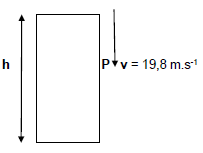
5.1 Define gravitational potential energy. (2)
5.2 Calculate the kinetic energy of the stone at point P on its way down. (3)
5.3 The stone strikes the ground and bounces off vertically upwards with a speed of 25 m.s-1. On its way up, the stone reaches point P and returns to the ground.
Use energy principles to calculate the height of the building, h. (IGNORE AIR RESISTANCE.) (8)
5.4 The engine of a racing car does 37 350 Joules of work in a race. Calculate the power output of the engine if the car travels for 20 s. Convert the units to horsepower. (4)
[17]
QUESTION 6 (Start on a new page.)
A cylindrical bar of length 400 mm is stretched to 405 mm when a force of 30 000 N is exerted on the bar.
The diameter of the bar is 50 mm.
6.1 Give a term for the internal restoring force per unit area of a body. (1)
6.2 Calculate the:
6.2.1 Strain on the bar (3)
6.2.2 Stress experienced by the bar (5)
6.3 The force exerted on the bar is changed and each time the force is changed the stress and strain are calculated.
The graph of stress vs strain for the bar is shown below.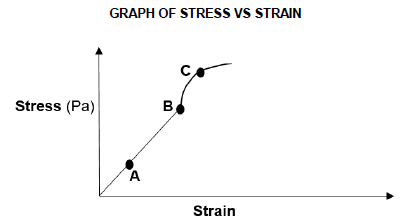
6.3.1 What does the gradient of the graph represent? (1)
6.3.2 Name the law that is investigated in this experiment. (1)
6.3.3 State the law mentioned in QUESTION 6.3.2 in words. (2)
6.4 Which letter (A, B or C):
6.4.1 Indicates the elastic limit? (1)
6.4.2 Lies in the elastic region? (1)
6.5 Perfectly elastic bodies are characterised by a property whereby the body regains its original shape and size when the deforming force is removed.
Write down:
6.5.1 A term for the underlined phrase (1)
6.5.2 TWO examples of objects that are perfectly plastic (2)
6.5.3 The NAME of a force that is always equal and opposite to the deforming force (1)
[19]
QUESTION 7 (Start on a new page.)
7.1 A group of learners carried out an investigation to compare the viscosities of three different liquids P, Q and R at 25 °C.
The learners dropped the same marble in equal columns of the liquids P, Q and R in identical containers. They then measured the time it took the marble to fall to the bottom of each liquid.
tp, tq and tr are the times taken by the marble to fall to the bottom of the container in liquids P, Q and R respectively.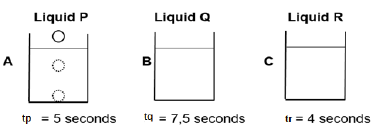
7.1.1 Define the term viscosity. (2)
7.1.2 Which liquid (P, Q or R) has the HIGHEST viscosity? Explain the answer. (3)
The THREE liquids (P, Q and R) are heated to 40 °C and the experiment is repeated at 40 °C. 7.1.3 How will the time of flow of the liquids be affected? Write only HIGHER, LOWER or THE SAME. Explain the answer. (3)
7.1.4 Calculate the pressure at a depth of 10 m in liquid A given that the density of liquid A is equal to 1000 kg.m-3. (3)
7.2 A hydraulic lift at a fuel station uses compressed air to lift a truck weighing 20 000 N.
The compressed air exerts a force on a small piston (PISTON 1) with a circular cross-sectional area of 0,045 m2. The pressure is transmitted by a hydraulic fluid to a larger piston (PISTON 2) of area 0,28 m2. The diagram below shows the hydraulic lift.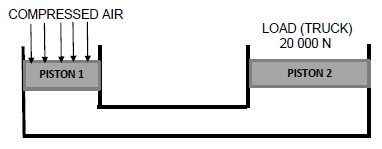
7.2.1 State Pascal’s principle in words. (2)
7.2.2 Calculate the magnitude of the minimum force that the compressed air must exert to lift the truck. (4)
[17]
QUESTION 8 (Start on a new page.)
The diagrams below show electromagnetic spectrum. The electromagnetic spectrum is the complete range of electromagnetic wave frequencies and wavelengths.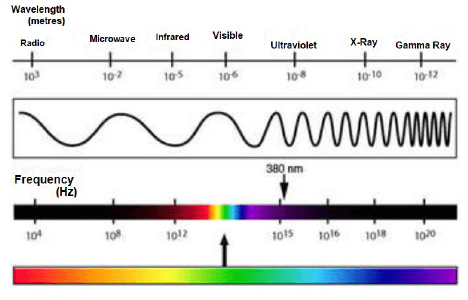
8.1 Write down ONE use of each radiation below:
8.1.1 Microwaves (1)
8.1.2 X-rays (1)
8.2 Name the electromagnetic wave that has the HIGHEST energy photons. (1)
8.3 An electromagnetic wave has a frequency of 5 x1017 Hz.
Calculate the wavelength of this wave. (3)
8.4 Consider an electromagnetic light wave with a wavelength of 502 nm. Calculate the energy of a photon of this light. (3)
[9]
QUESTION 9 (Start on a new page.)
9.1 Use the ray diagram below to answer the questions that follow.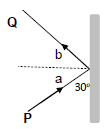
9.1.1 Write down the NAME of the phenomenon illustrated above. (1)
9.1.2 State TWO requirements for the phenomenon in the diagram above. (2)
9.1.3 Write down the NAME and the VALUE of angle b (2)
9.2 Visible light undergoes dispersion when it strikes glass.
9.2.1 Define dispersion of light. (2)
9.2.2 Which colour of light is least refracted when light undergoes dispersion? Explain the answer in terms of wavelength. (3)
9.3 In the diagram below ray of light strikes a glass-air interface. The light bends as it enters a medium of different optical density. Glass is more optically dense than air.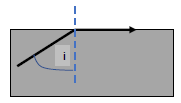
9.3.1 Write down a term for the underlined sentence. (1)
9.3.2 What special name is given to the angle of incidence , i, when the effect in the diagram occurs? (1)
9.3.3 Name the phenomenon that occurs when the angle i is increased (1)
9.3.4 Name TWO applications of the phenomenon mention in QUESTION 9.3.3. (2)
9.4 Consider the diagram below in which an object of height 1 cm is placed at point O between optical centre and focal point of a convex lens. The focal length is 2 cm.
9.4.1 On the diagram sheet attached to this question paper, use a ruler to construct accurately the position of the image. (5)
9.4.2 Write down ONE property of the image formed in QUESTION 9.4.1 above. (1)
[21]
TOTAL: 150
DATA FOR TECHNICAL SCIENCES
GRADE 12
PAPER 1
TABLE 1: PHYSICAL CONSTANTS
NAME | SYMBOL | VALUE |
Acceleration due to gravity | g | 9,8 m·s-2 |
Speed of light in a vacuum | c | 3,0 x 108 m·s-1 |
Planck's constant | h | 6,63 x 10-34 J·s |
Permittivity of free space | ɛ0 | 8,85 × 10-12 F.m-1 |
TABLE 2: FORMULAE
FORCE
WORK, ENERGY AND POWER
ELASTICITY, VISCOSITY AND HYDRAULICS
WAVES, SOUND AND LIGHT
ELECTROSTATICS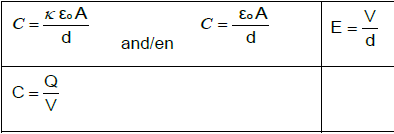
CURRENT ELECTRICITY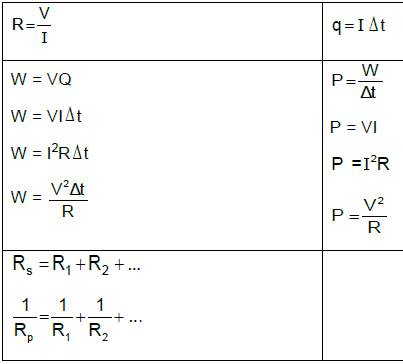
ELECTROMAGNETISM
ELASTICITY, VISCOSITY AND HYDRAULICS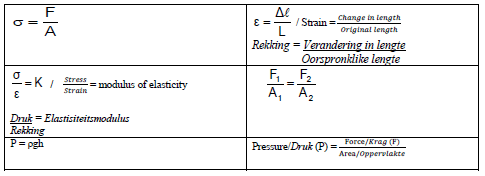
9.4.1 DIAGRAM SHEET